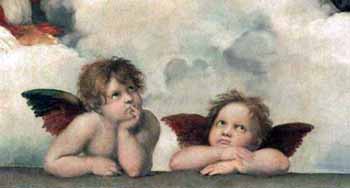
Cherubs from the Sistine Madonnaalso known as Cherubs from the Madonna of San Sisto

|
Cherubs from the Sistine Madonna
The art piece ‘Cherubs from the Sistine Madonna’ was originally a part of the famous painting ‘Sistine Madonna’, more commonly known as ‘The Madonna of San Sisto’. The masterpiece was created by Raphael (Sanzio) between 1513 and 1514. The two cute cherubs in this painting are quite possibly the most famous angels/cherubs ever painted in art’s history.
History
The original ‘The Madonna of San Sisto’ was commissioned by Pope Julius II, who is depicted in the painting as the Holy Sixtus. Descended from the noble Della Rovere family of Italy, Pope Julius II may have requested the painting for his tomb, as the patron saint of his family was Saint Sixtus. The painting’s figures consist of the Virgin Mary holding the Christ child, Saint Sixtus, and Saint Barbara who is looking down at the little cherubs whose facial expression seems to imply boredom and restlessness. They appear eager to finish their holy duties and be free to play. Regardless of their intent, they add a sense of intrigue to the scene, contrasting beautifully with the humourless miens of the figures above them.
The painting was sold to Germany by the monks of the Benedictine Monastery, where it was originally displayed on the altar of the church of San Sisto in Piacenza.
Analysis and Review
“One of the most frequently discussed and a best-loved painting of the Renaissance is Raphael's so-called Sistine Madonna. For many people it remains the supreme example of western painting, and its popularity is virtually as great as that of the Mona Lisa. All who have written about this picture have acknowledged the strange and baffling expressions worn by Mary and the child Jesus, although attempts to decipher their meaning have frequently been evasive – “visionary pictorial composition” was one interpretation.” Rolf Toman – “The Art of the Italian Renaissance: Architecture, Sculpture, Painting, Drawing”
The ‘Cherubs from the Sistine Madonna’ by Raphael (Sanzio) can be viewed in the Gemäldegalerie Alte Meister in Dresden, Germany.












